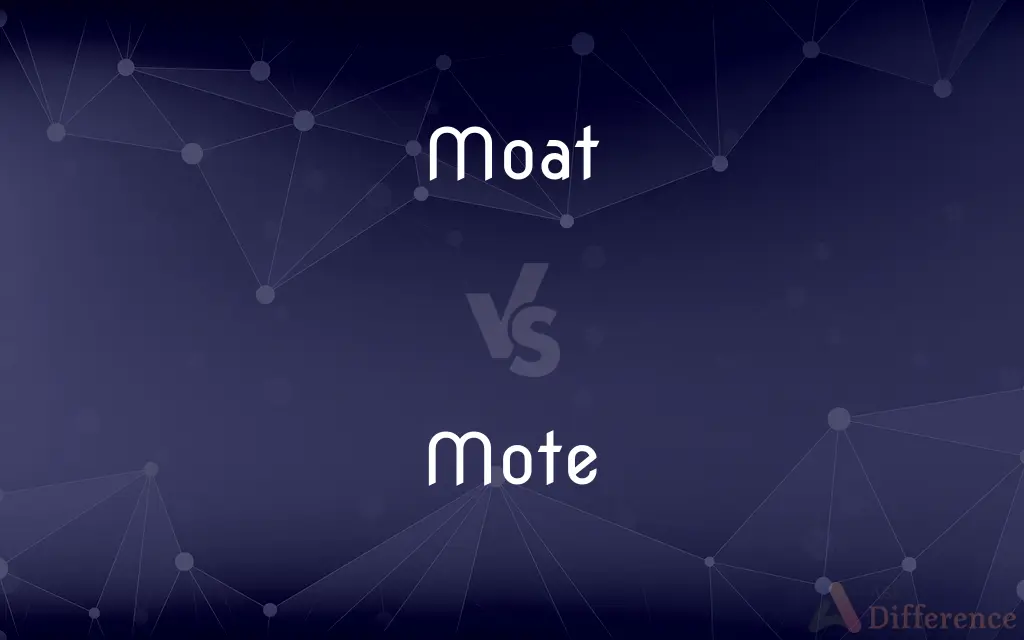Moat vs. Mote — What's the Difference?
By Urooj Arif & Maham Liaqat — Updated on April 8, 2024
A moat is a wide, deep ditch surrounding a castle for defense, often filled with water, while a mote is a small particle or speck, especially of dust.

Difference Between Moat and Mote
Table of Contents
ADVERTISEMENT
Key Differences
A moat serves as a defensive feature historically used in fortifications, designed to make it difficult for attackers to reach the walls of a castle, town, or other secured area. Typically filled with water, it also served as a sewer and barrier against underground intrusion. In contrast, a mote is simply a tiny piece of matter, like a dust particle, often used metaphorically to emphasize minuteness or insignificance in various contexts.
Moats were an essential part of medieval architecture, reflecting the need for physical barriers in military strategy and the protection of valuable or strategic sites. Motes, however, are ubiquitous in nature and daily life, symbolizing the trivial or easily overlooked elements in the environment or in philosophical discussions.
While the construction of a moat required considerable planning, resources, and labor, highlighting the importance and wealth of the protected site, the presence of a mote is a common, natural occurrence, requiring no human effort and often associated with light and visibility when observed in beams of sunlight.
The significance of a moat lies in its historical and architectural value, representing human ingenuity in ancient warfare and defense mechanisms. Conversely, a mote's significance is more poetic or philosophical, often used in literature and speeches to convey ideas of purity, insignificance, or the human condition.
Understanding the distinction between moat and mote is not just about their definitions but also about recognizing the vast differences in their usage, implications, and the contexts in which they appear. While one conjures images of castles and medieval battles, the other evokes the microscopic and the mundane.
ADVERTISEMENT
Comparison Chart
Definition
A deep, wide ditch surrounding a fortification, filled with water.
A small particle or speck, especially of dust.
Purpose
Defense against attackers and prevention of tunneling.
No functional purpose; often referenced for its small size.
Historical Significance
Integral to medieval warfare and architecture.
Minimal; more relevant in literary or metaphorical contexts.
Construction/Formation
Man-made, requiring significant effort and resources.
Natural occurrence or result of everyday activities.
Associations
Castles, history, warfare, and protection.
Insignificance, the natural world, light, and visibility.
Compare with Definitions
Moat
Served multiple defensive purposes.
The moat prevented attackers from digging tunnels under the walls.
Mote
Visible in certain light conditions.
Motes danced in the sunlit room.
Moat
Reflects architectural and historical significance.
Moats were common in European and Japanese fortifications.
Mote
A tiny particle of dust or matter.
A single mote of dust floated in the beam of sunlight.
Moat
Integral to the layout of ancient fortifications.
Moats added to the aesthetic and strategic depth of medieval castles.
Mote
Symbolizes something very small or insignificant.
He described his feelings as less than a mote in the vast universe.
Moat
A fortified ditch around a castle, often filled with water.
The ancient castle was impenetrable with its wide moat.
Mote
Used metaphorically in literature.
Writers often speak of a mote in someone's eye.
Moat
Symbolizes medieval defense mechanisms.
The moat was a critical part of the fortress's defenses.
Mote
Represents the trivial or overlooked.
The scientist found beauty in the motes suspended in air.
Moat
A moat is a deep, broad ditch, either dry or filled with water, that is dug and surrounds a castle, fortification, building or town, historically to provide it with a preliminary line of defence. In some places moats evolved into more extensive water defences, including natural or artificial lakes, dams and sluices.
Mote
A very small particle; a speck
"Dust motes hung in a slant of sunlight" (Anne Tyler).
Moat
A deep wide ditch, usually filled with water, typically surrounding a fortified medieval town, fortress, or castle as a protection against assault.
Mote
A small particle; a speck.
Moat
A ditch similar to one surrounding a fortification
A moat separates the animals in the zoo from the spectators.
Mote
(obsolete) A meeting for discussion.
A wardmote in the city of London
Moat
To surround with or as if with a moat.
Mote
(obsolete) A body of persons who meet for discussion, especially about the management of affairs.
A folk mote
Moat
A deep, wide defensive ditch, normally filled with water, surrounding a fortified habitation.
Mote
(obsolete) A place of meeting for discussion.
Moat
An aspect of a business which makes it more "defensible" from competitors, because of the nature of its products, services or franchise or for some other reason.
Mote
A tiny computer for remote sensing; a component element of smartdust.
Moat
A circular lowland between a resurgent dome and the walls of the caldera surrounding it.
Mote
(archaic) May or might.
Moat
(meteorology) A clear ring outside the eyewall of a tropical cyclone.
Mote
(obsolete) Must.
Moat
(obsolete) A hill or mound.
Mote
(archaic) Forming subjunctive expressions of wish: may.
Moat
(transitive) To surround with a moat.
Mote
See 1st Mot.
Moat
A deep trench around the rampart of a castle or other fortified place, sometimes filled with water; a ditch.
Mote
A meeting of persons for discussion; as, a wardmote in the city of London.
Moat
To surround with a moat.
Mote
A body of persons who meet for discussion, esp. about the management of affairs; as, a folkmote.
Moat
Ditch dug as a fortification and usually filled with water
Mote
A place of meeting for discussion.
Mote
A small particle, as of floating dust; anything proverbially small; a speck.
The little motes in the sun do ever stir, though there be no wind.
We are motes in the midst of generations.
Mote
(nontechnical usage) a tiny piece of anything
Common Curiosities
Are motes only related to dust?
While commonly associated with dust, mote can refer to any small particle.
How did moats provide defense?
Moats provided defense by creating a physical barrier against attackers and preventing tunneling under walls.
What is a moat?
A moat is a wide, deep ditch, often filled with water, surrounding a castle or fortification for defense.
Were moats used in all castles?
Not all, but many castles, especially those in strategic locations or of significant importance, featured moats.
Did moats serve purposes other than defense?
Beyond defense, moats also served as waste disposal and could deter wildlife.
How can a mote be seen?
Motes are often visible in beams of light, such as sunlight coming through a window.
What challenges did constructing a moat involve?
Constructing a moat involved challenges like diverting water sources, excavation, and ensuring structural stability of the surrounding fortification.
What does mote mean?
Mote refers to a tiny particle, speck, or piece of dust.
Can moats be found today?
Yes, many historical sites and castles with moats still exist, some maintained as historical landmarks.
What is the metaphorical use of mote?
Metaphorically, mote is used to signify something very small or insignificant, often in philosophical or moral discussions.
Is the concept of a mote significant in science?
In science, the concept of a mote can be significant in studies related to air quality, demonstrating the presence of particulate matter.
Can mote be used to describe things other than dust?
Yes, mote can describe any small or minute particle, not just dust.
How do motes affect air quality?
Motes, especially in large quantities, can affect air quality and visibility, and are of concern in environmental science.
Why are moats not used in modern architecture?
Modern warfare and security technologies have made the defensive function of moats obsolete.
What lessons can be learned from the historical use of moats?
The use of moats teaches about historical defense strategies, engineering challenges, and the lengths to which societies would go to protect valuable assets.
Share Your Discovery

Previous Comparison
Dollar vs. Cent
Next Comparison
Partridge vs. QuailAuthor Spotlight
Written by
Urooj ArifUrooj is a skilled content writer at Ask Difference, known for her exceptional ability to simplify complex topics into engaging and informative content. With a passion for research and a flair for clear, concise writing, she consistently delivers articles that resonate with our diverse audience.
Co-written by
Maham Liaqat















































